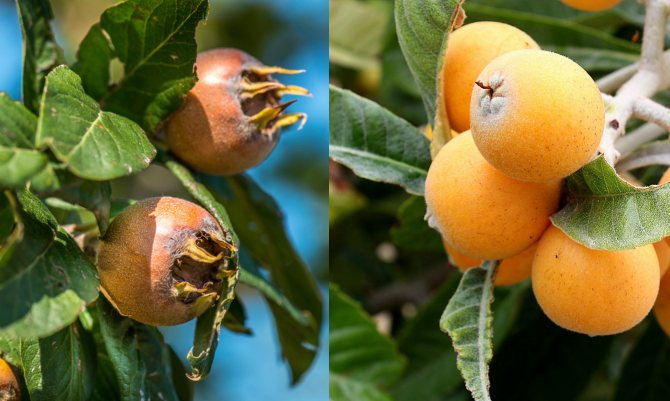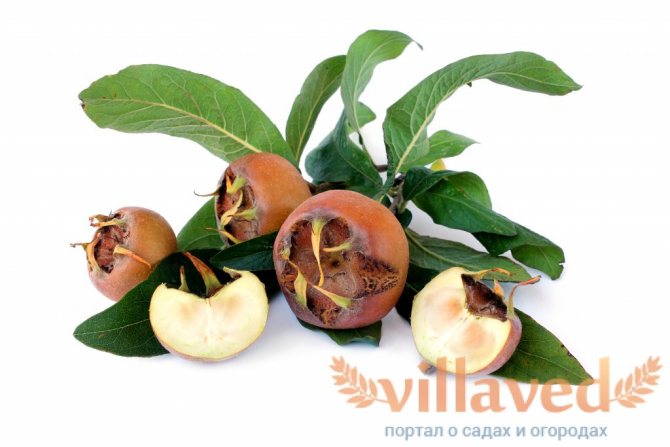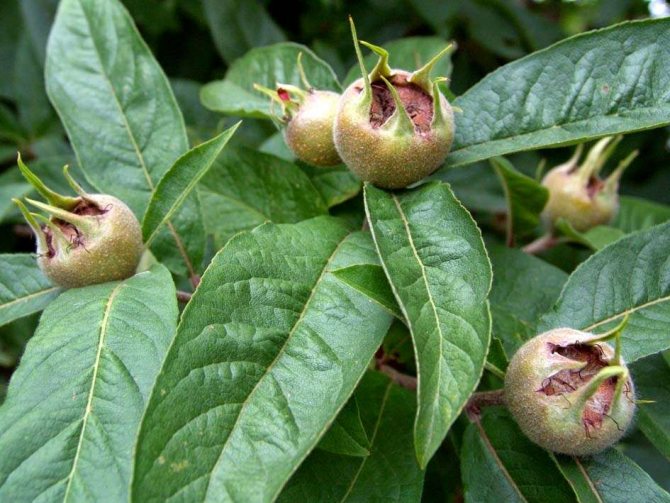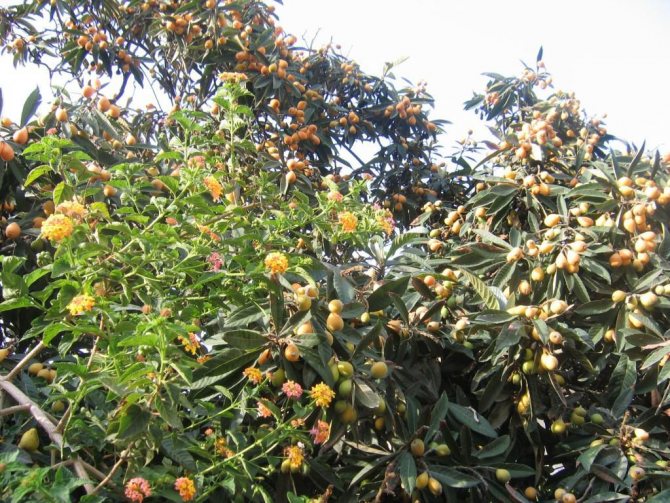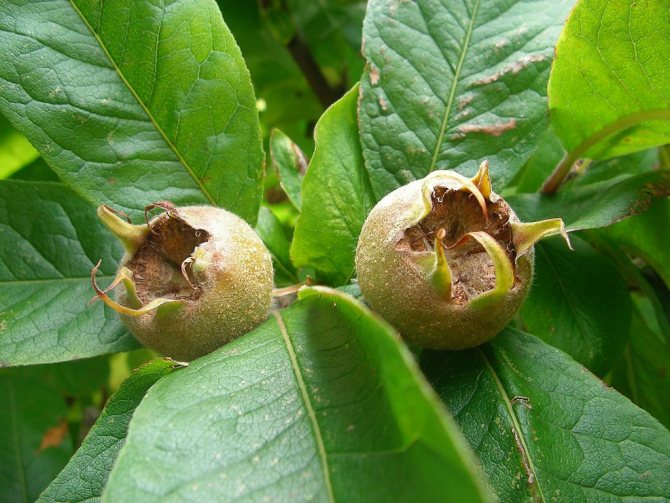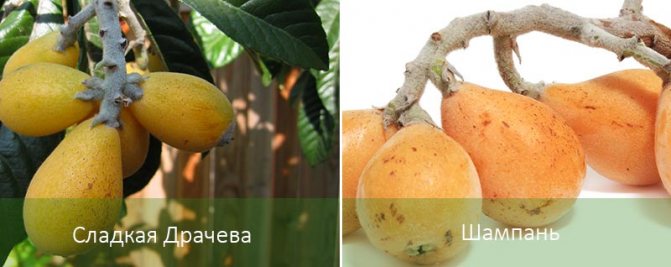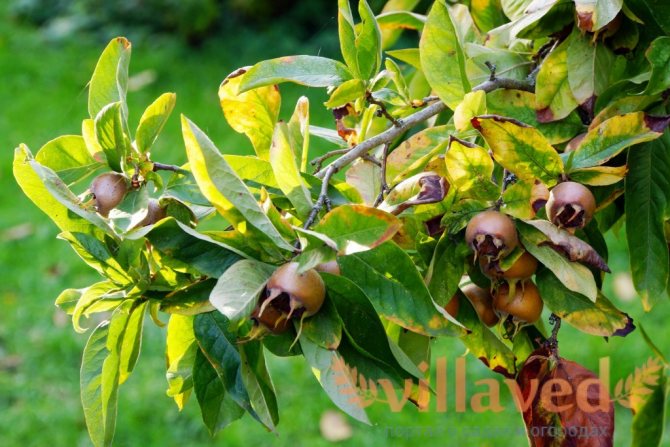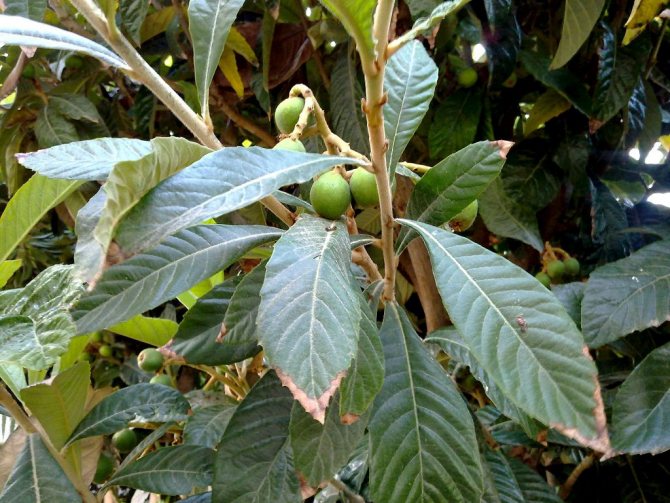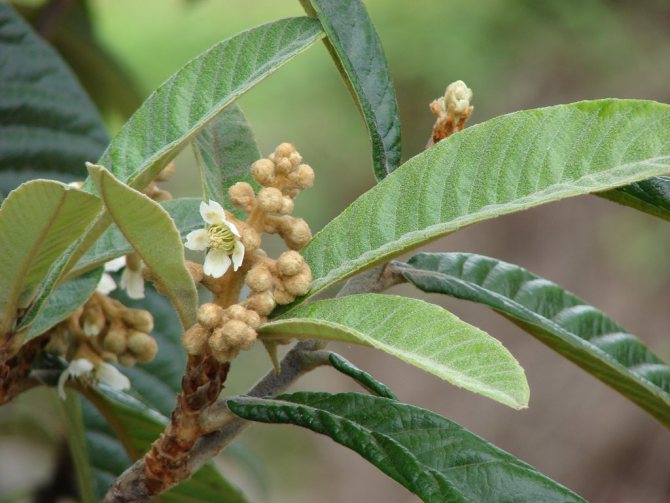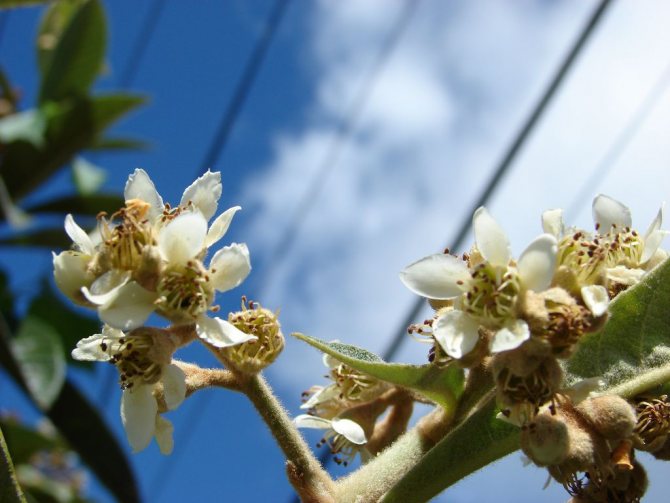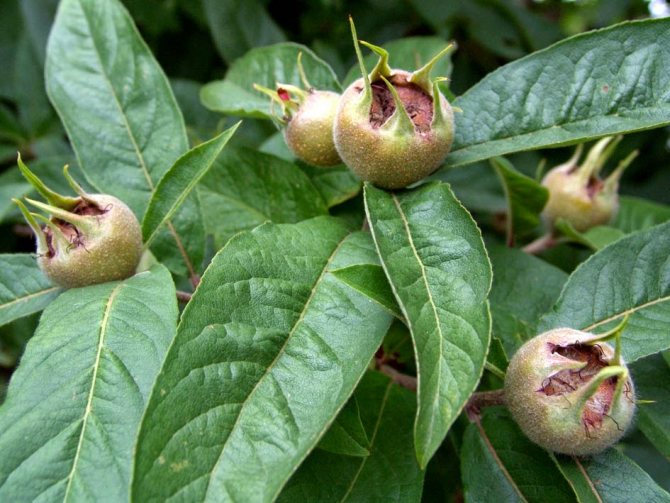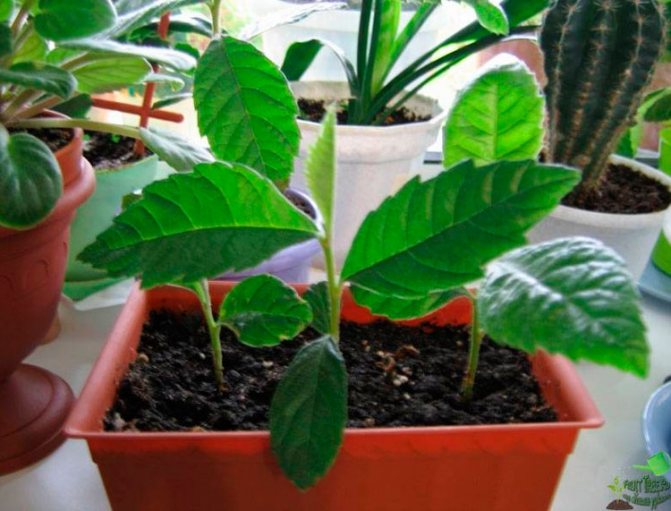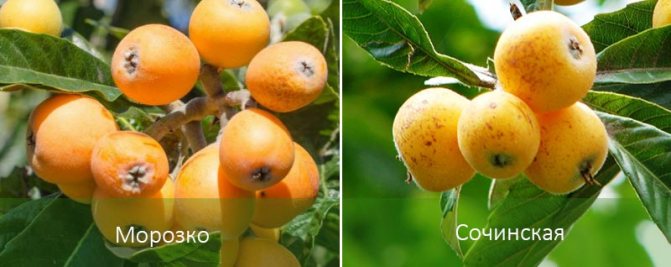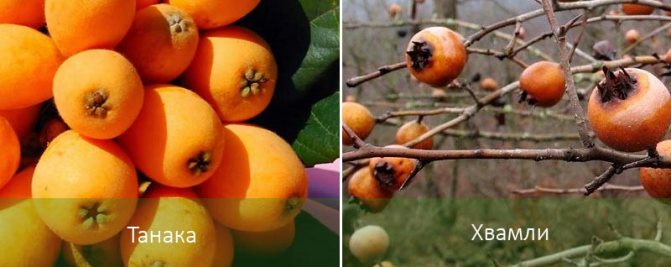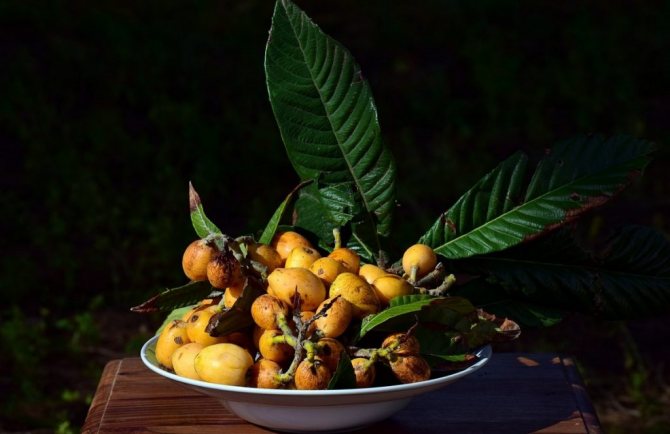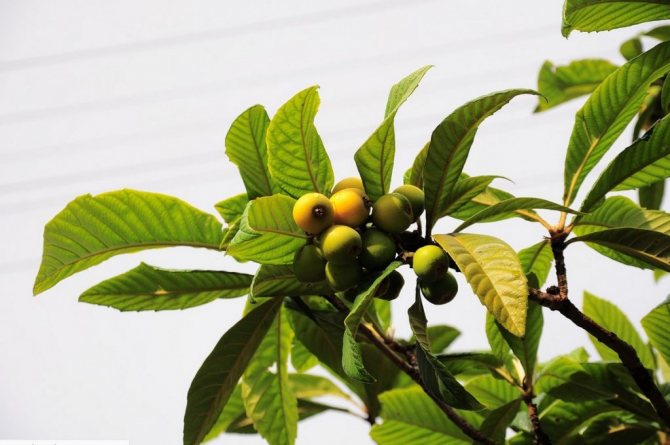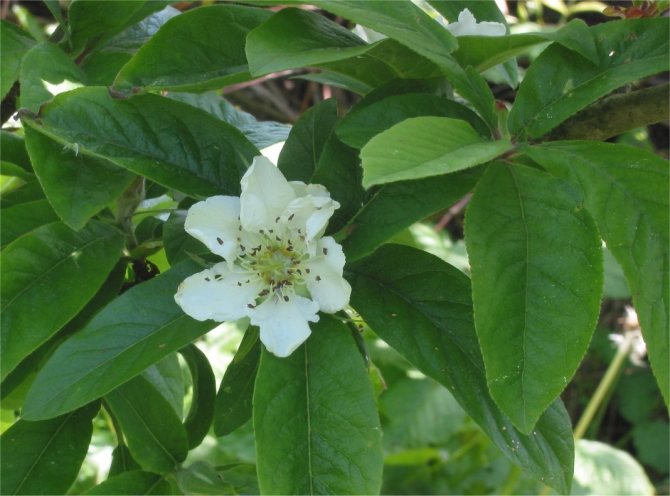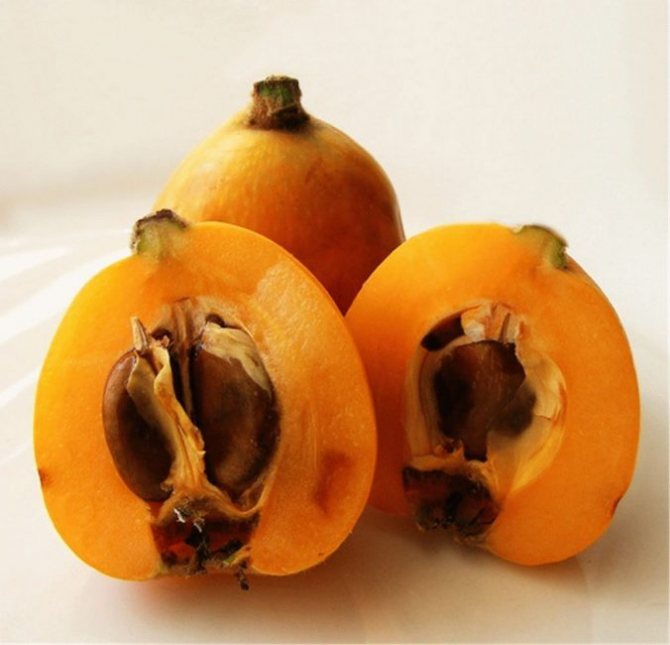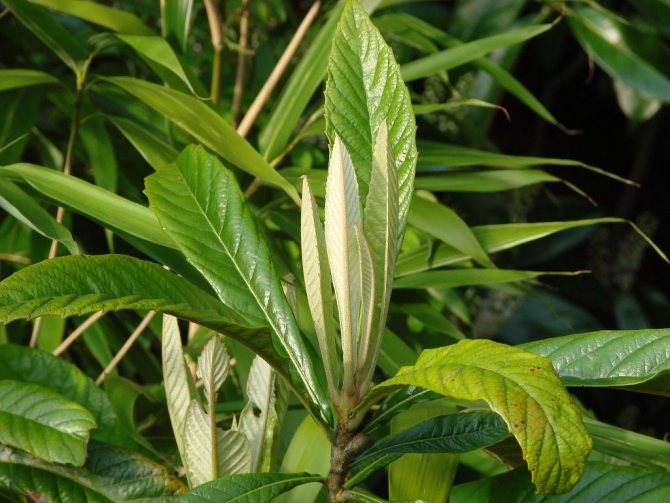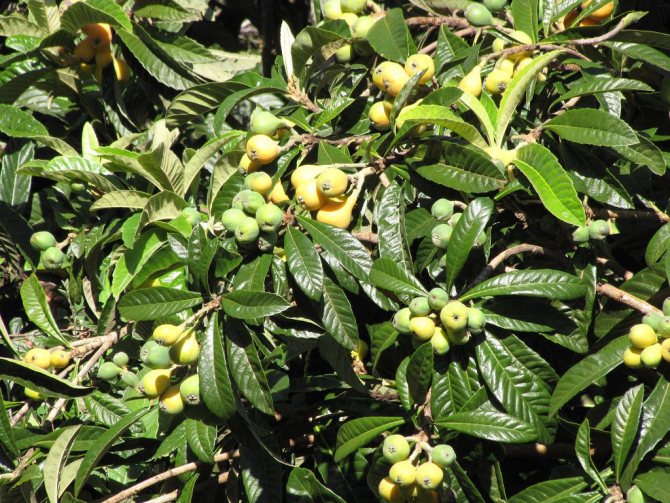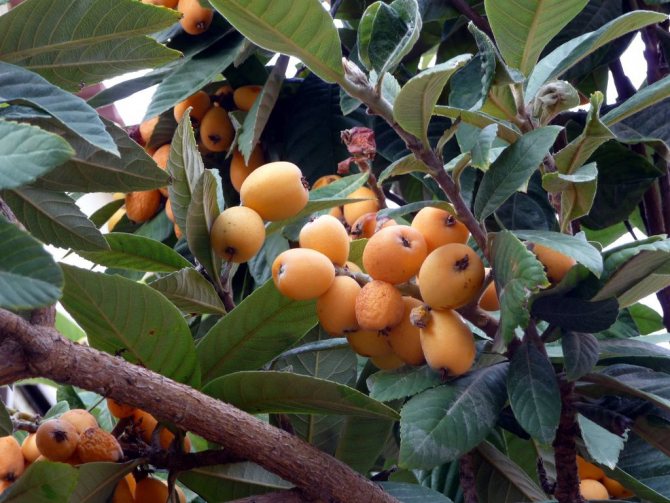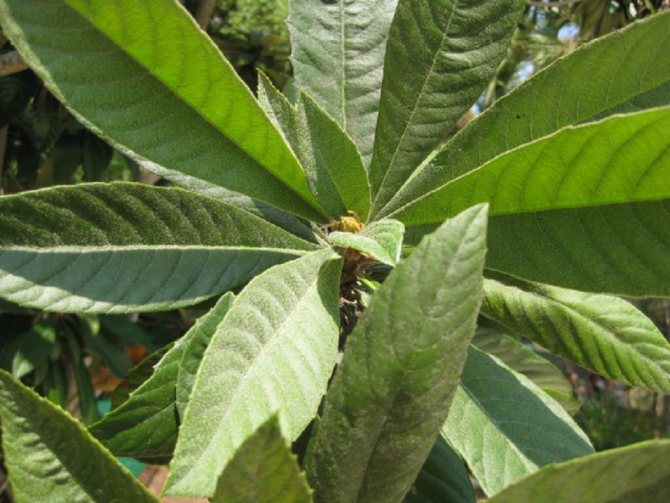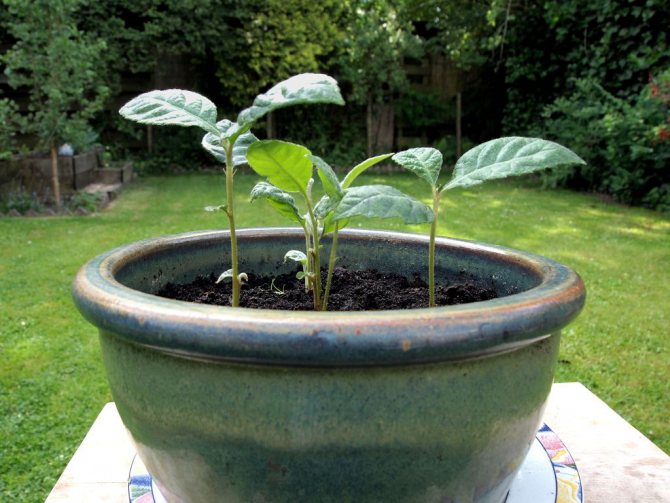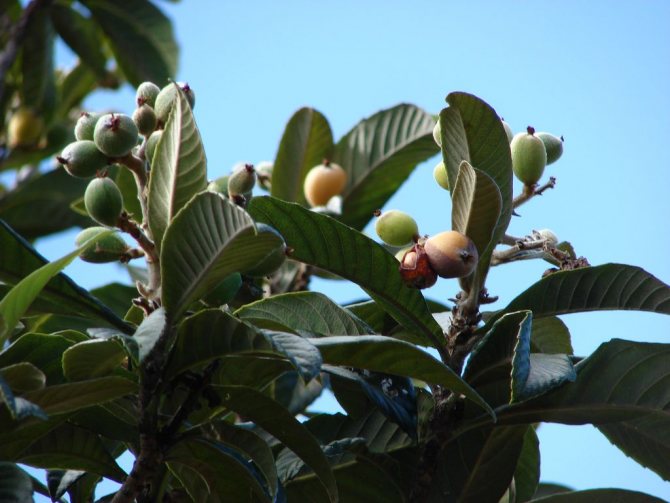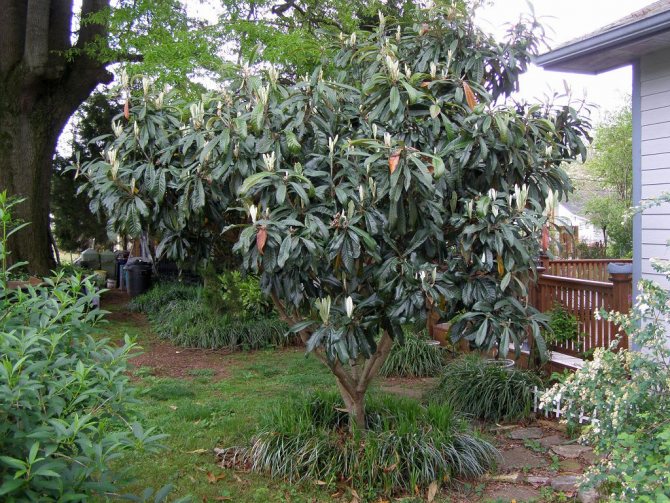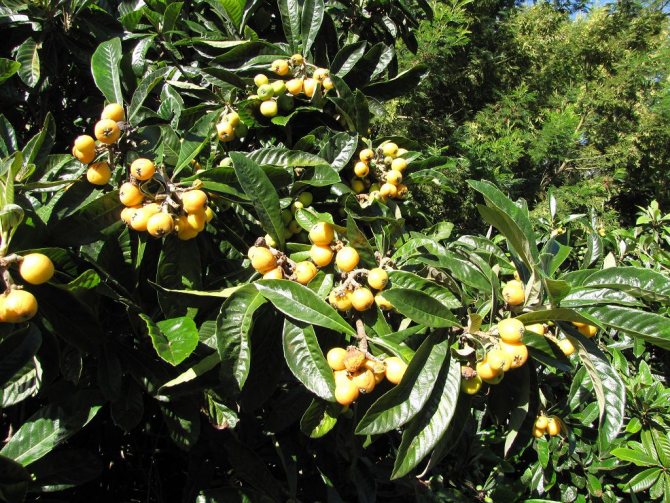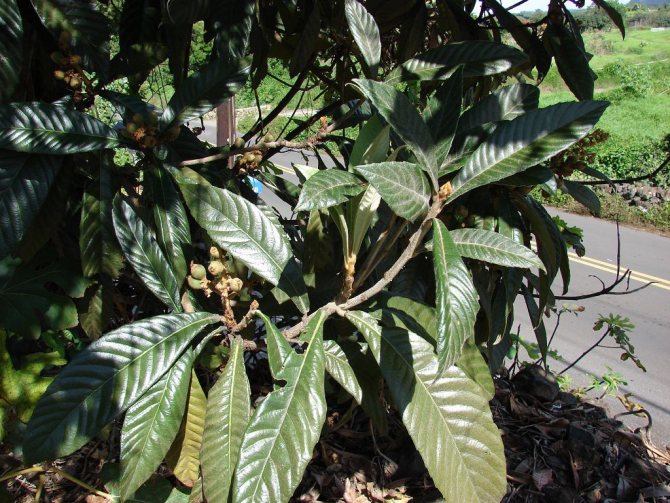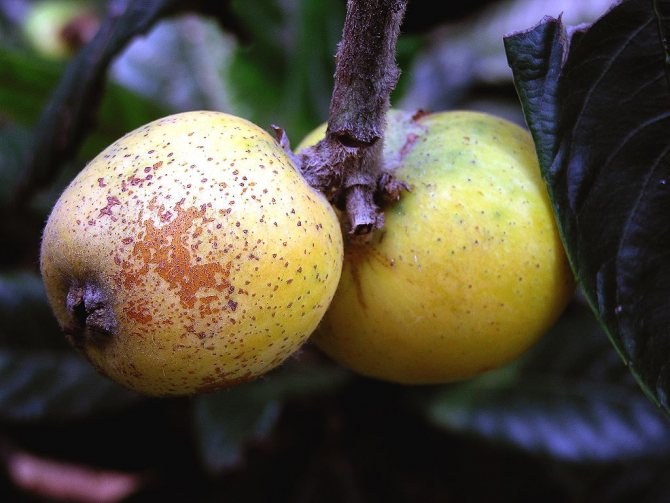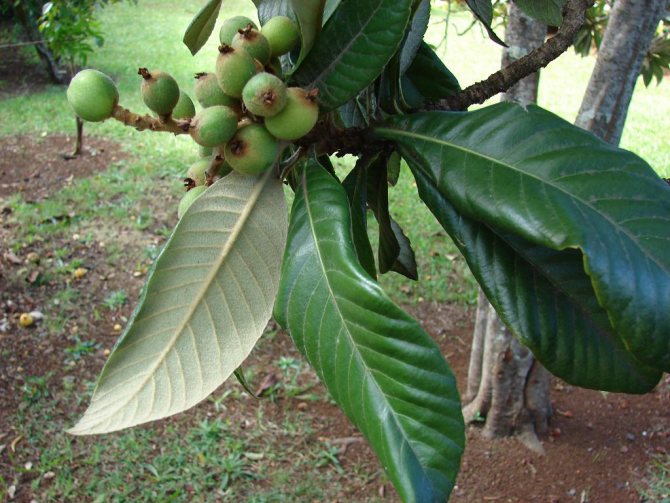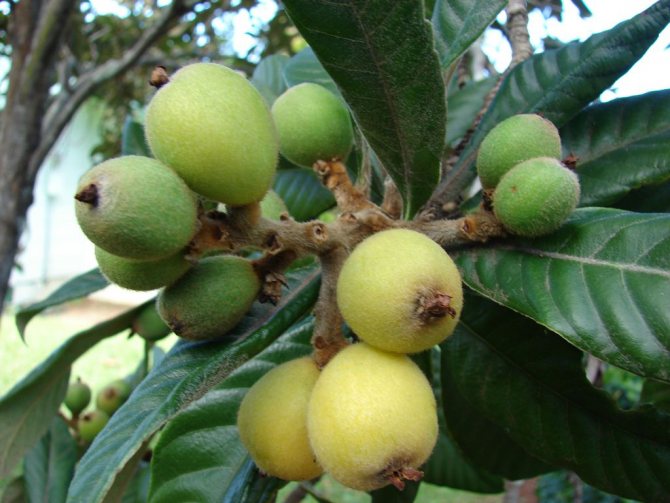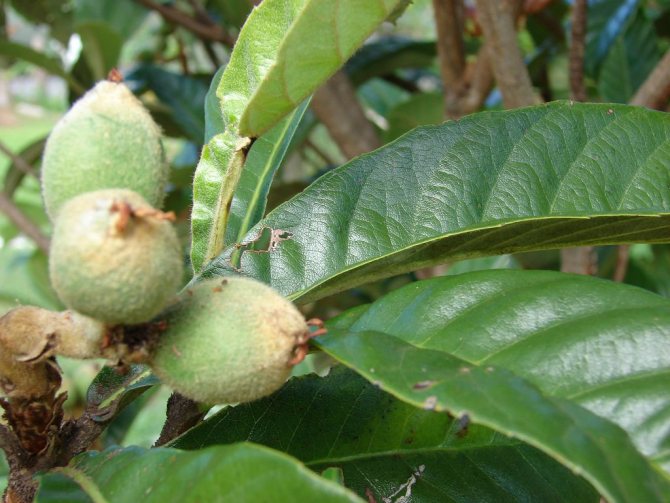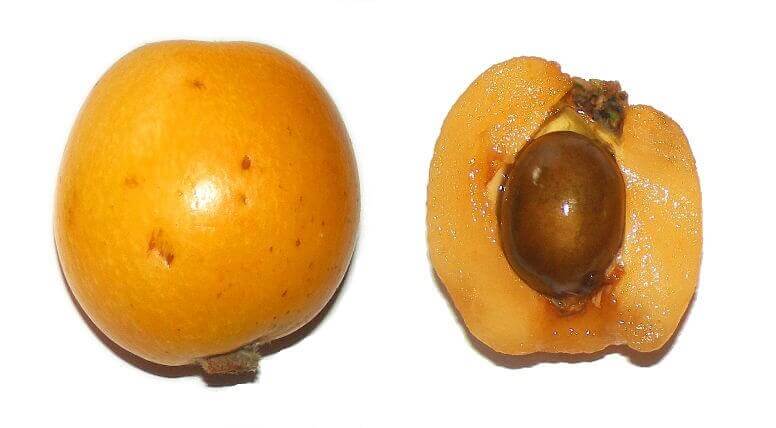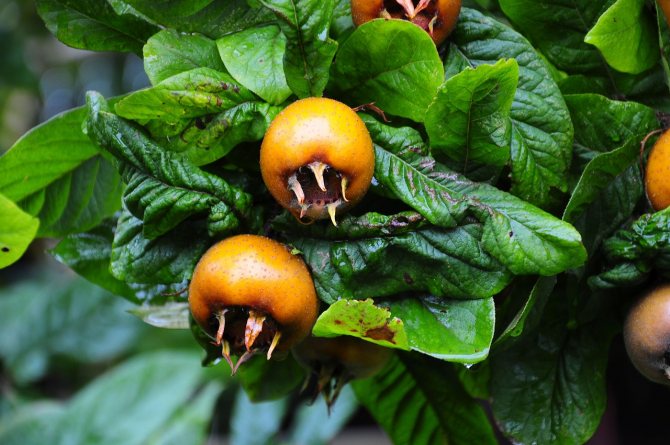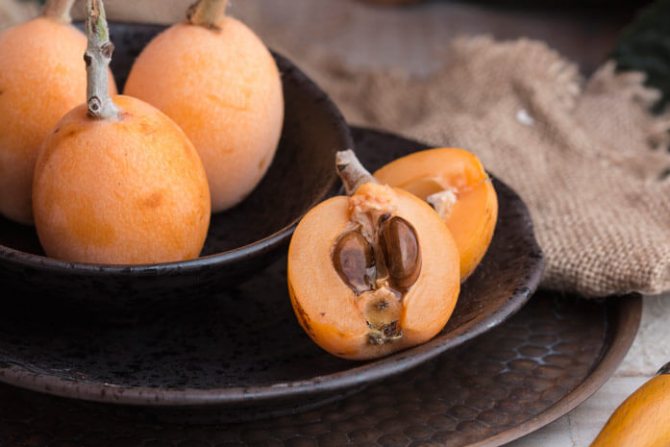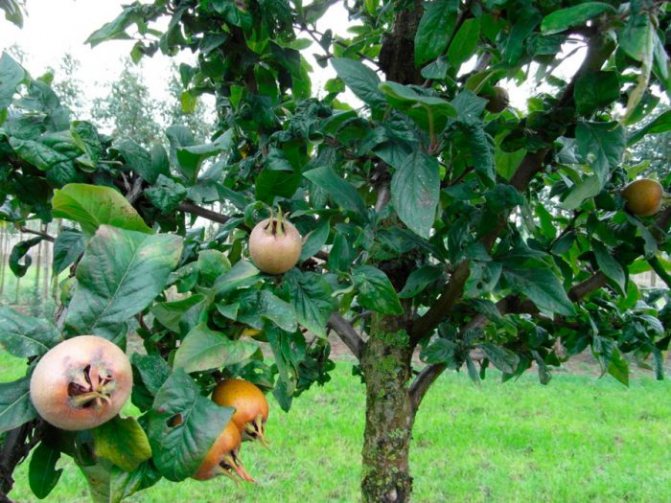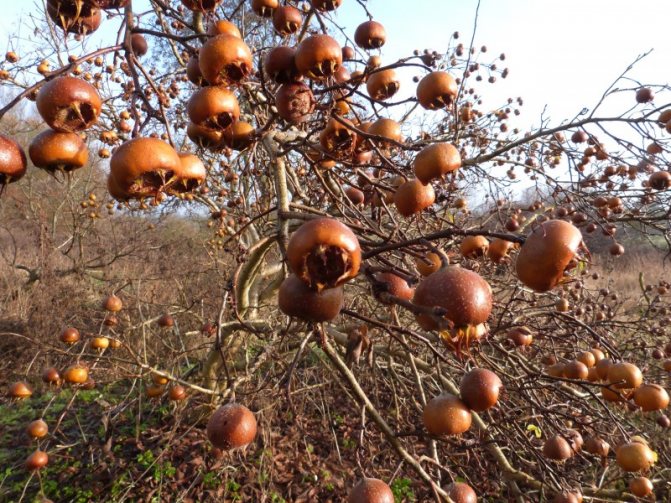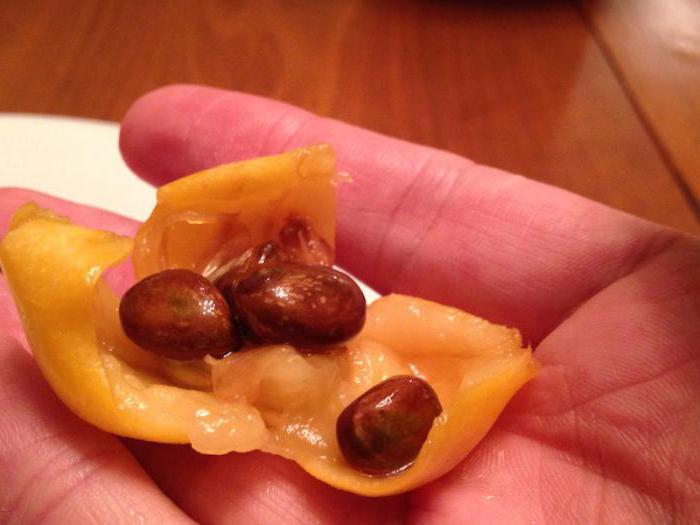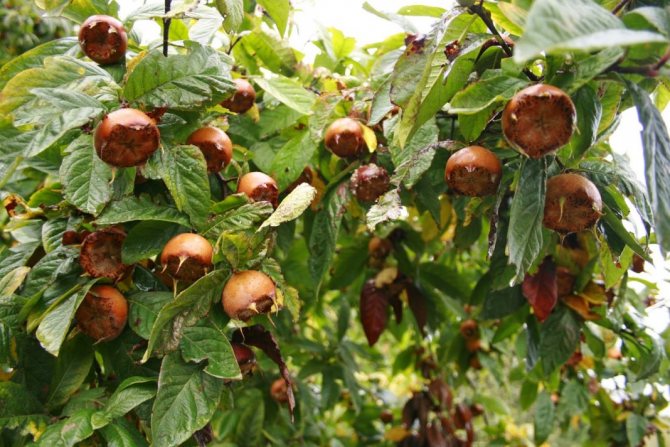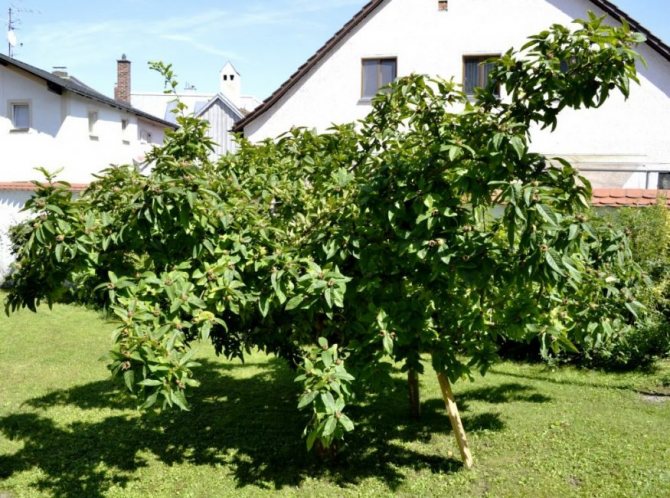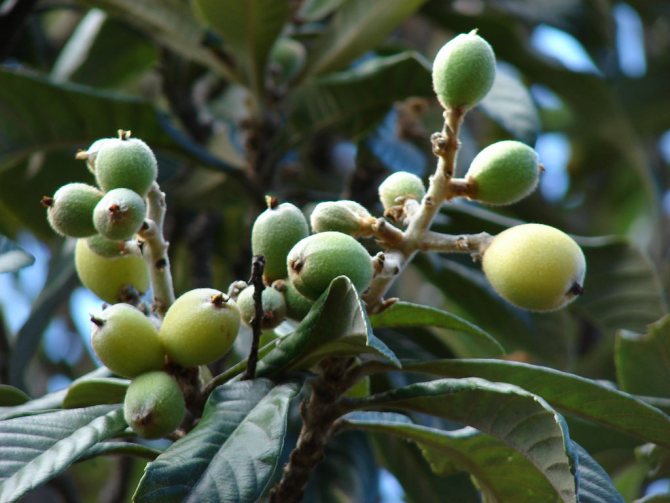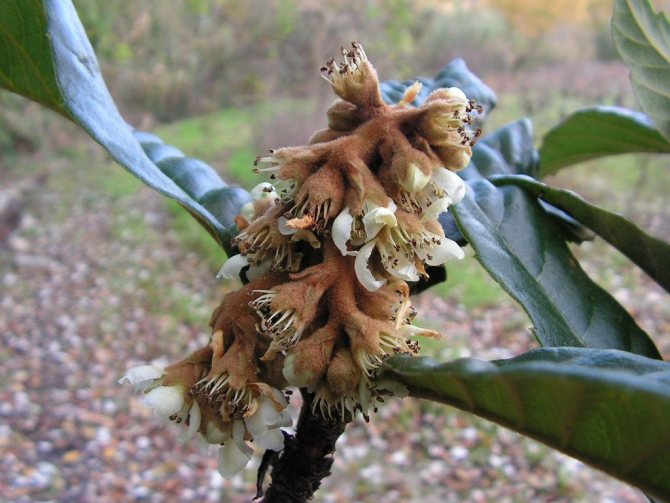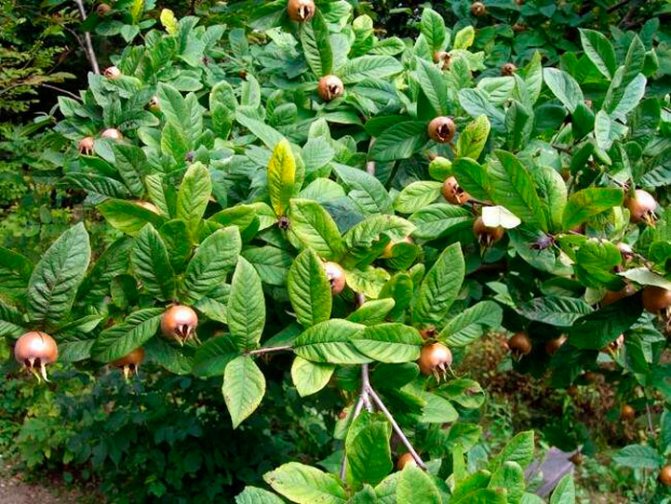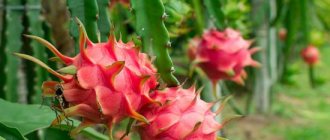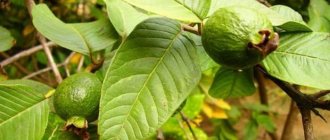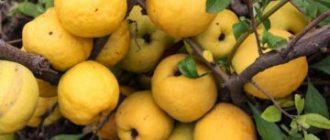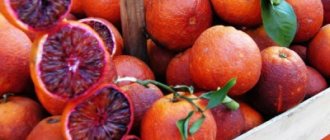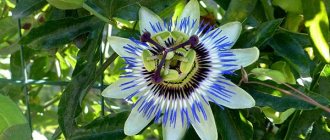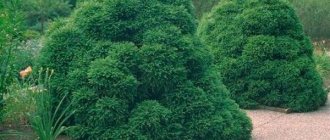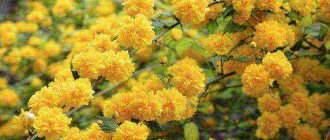Medlar or "lokva" is an interesting evergreen plant. The fruits of this fruit tree are endowed with useful properties and can bring many benefits. Visually, the medlar fruit resembles an apricot. Having a rather thick peel, inside it is very soft, and the taste resembles a mixture of apple, apricot and strawberry.In addition to the fact that the fruit itself is edible, its seeds (4 large enough) can also be used as a spice or additive in coffee (you need a high-quality grinding in both cases).
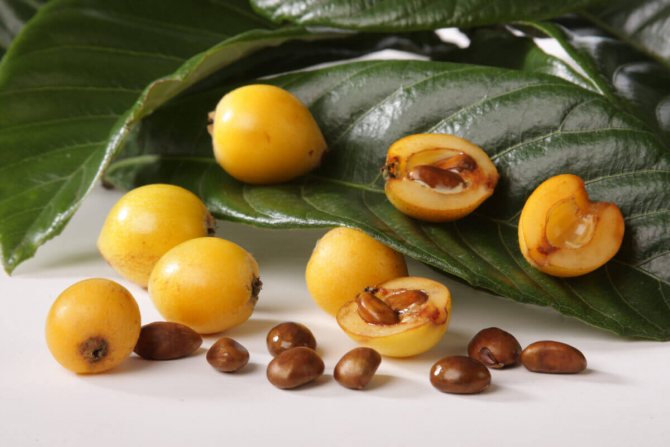
The homeland of Lokva is Asia. The plant came to Europe at the end of the 18th century, and, apparently, the oriental fruit did not acquire wide popularity. A rather strange fact is that the medlar was carried so far north from the homeland and is successfully grown in Germany and the Moscow region. And all because it is able to withstand short-term frosts down to -15, which is quite a lot for a southerner.
There are about 30 types of medlar, but the most famous are 2:
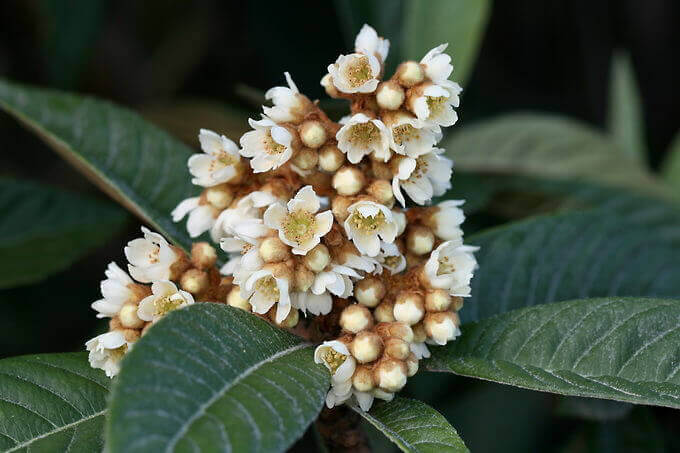

japanese medlar
- grows only in warm climates, blooms in October, and fruits ripen by May and June. The color has a white-cream color, and the fruit is light orange in something similar to a pear up to 10 cm long;- Caucasian (aka Germanic)
- better adapted to the temperate climate of southern Germany, Crimea, Caucasus. It begins to bloom at the end of May, and gives fruits closer to November. This medlar is almost half the size of Japanese medlar, and the fruit has a reddish brown color.
Medlar what is it where it grows how it looks
The fruit of the southern fruit tree, similar to an apricot or a pear, yellow or orange, is what loquat is. The word is Turkish with Greek roots.
Botanical description
Medlar fruit is a plant of the Pink family, a botanical relative of quince and pear.
The tree grows 6-9 meters, its bark is gray, with small thorns.
The dimensions of the dark green elliptical leaves are from 8 to 25 cm in different species, the flowers are fragrant, white or pinkish, five-petal. After flowering, a "drupe" ovary begins to form. The fruits of the medlar outwardly resemble a large apricot or pear.
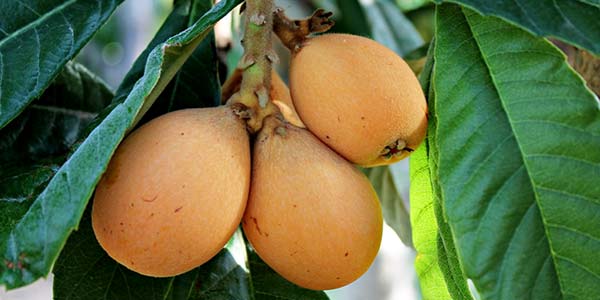

Medlar is the only fruity subtropical exotic that blooms in autumn and bears fruit in winter and spring.
Distribution history
The homeland of the medlar is considered to be different regions of the northern hemisphere of the planet. The Japanese variety of fruit comes from the humid subtropics of Japan and China, where it is popular on the mountain slopes. Contrary to its name, the Germanic species of medlar came from Southwest Asia and Southeast Europe.
Wild medlar plantations are widespread on the South Coast, the Black Sea coast of the Caucasus.
In Iran, Azerbaijan, Turkey, the plant has been cultivated for three millennia. Orchards were laid by the inhabitants of the Antique world, the fruits of the exotic were liked by the British. However, later the medlar was supplanted by other fruits, including the curiosities of the New World brought by the conquistadors.
The tree began to grow in Russia in the 19th century. Today, a useful plant is appreciated in the Caucasus, Ukraine, the USA, Iran, Japan, Abkhazia, Israel, Southern Europe (Italy, Spain).
For other latitudes, evergreen or shrub varieties are an exhibit of botanical gardens and private estates of exotic lovers.
Types of medlar
Three dozen varieties of medlar are classified, the most famous are German (she is ordinary or Caucasian) and Japanese.
- Medlar.Loves the sun, dryness, mild winters and cool summers. It was often planted near the country houses of Algeria and other former French colonies as a decorative element. Fruits with a diameter of 2.1-3.3 cm, dense, sour. Their sepals are always open, making the fruit appear hollow. In Russia, the fruit grows in the Caucasus and the South Coast, therefore it is called the Caucasian or Crimean medlar. In the North Caucasus, the name of the fruit "cones" is also used.
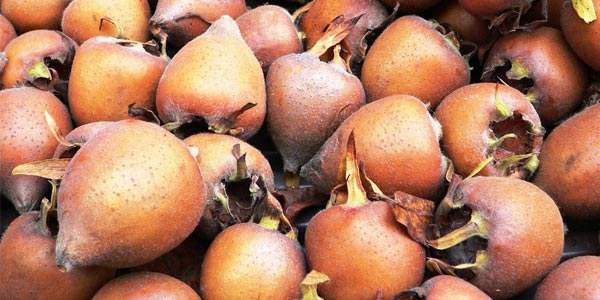

- Japanese medlar. A tree with a luxurious crown and leaves, which is twice as large as that of the Germanic variety. Equally loves sun and shade. It tolerates short-term frosts up to 13-15 °, but does not bear fruit in severe winters. With age, the winter hardiness of the medlar tree increases. Fruits are not well tolerated for transportation, therefore they are rarely exported. The most delicious loquat is fresh.
In Russia, it is cultivated on the Black Sea coast of the Caucasus, South Coast, in the Azov region, Dagestan. Other fruit names: nispero (in Spain), shesek (in Israel), lokva, biva.
Belonging to the same genus, they differ in a number of botanical characteristics:
| Characteristic | Japanese medlar | German medlar |
| Fruit rind | soft, color bright yellow | firm, brownish or brownish |
| Ovary formation | on young shoots | at last year |
| Presence of foliage | year-round | seasonal |
| Leaves | pubescent underneath, evergreen | waxy, turn red before falling off |
| Fruit ripening | April May | late fall |
| Number of seeds | 1-5 | 4-5 |
| Fruit taste | sweet | sourish, tart |
| Pulp | loose, juicy, | dense, dryish |
| Frost resistance | good | average |
Medlar - how to grow at home from a bone
Medlar is a large shrub or small tree up to 5 meters high. Medlar is easy to grow and is often used as an ornamental plant. Due to the shallow root system of the medlar, care must be taken when growing and replanting so as not to damage the roots.
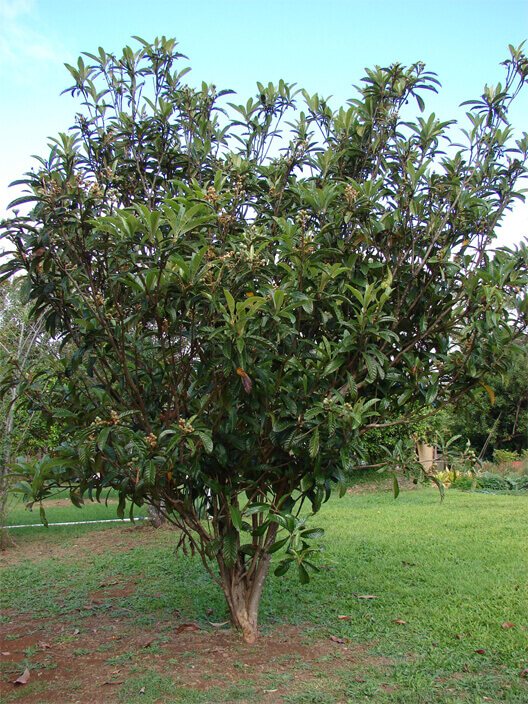

Growing medlar at home is possible, and does not bear any special difficulties. Medlar, although an exotic plant, is quite unpretentious in care. It is successfully cultivated and grows in the Crimea and in the Moscow region - but only in greenhouse conditions. The temperature in winter is often below -15 and even the German medlar is not worth hoping for a successful winter.
You can grow both Japanese and German medlar in an apartment. To do this, you will need:
- Soak the bone in water at room temperature for a day. The bone should be at the bottom and if it comes up, we start over;
- Then we can plant it in potting soil to a depth of 3-4 cm. It is better to immediately choose a large bucket - for the future;
- Medlar should be watered regularly - twice a week. Spray the leaves with warm water once a month;
- You need to replant every 2-3 years, changing the soil. Fertilizers also do not hurt, but their use in an apartment is quite impractical, in my opinion.
You can grow a seedling from a seed of both Germanic and Japanese medlar. If there is a summer cottage and you are considering the possibility of a subsequent outdoor landing, choose the German one. In the mode of leaving, they practically do not differ, but later the German one will more easily get used to the temperate climate.
Medlar composition and calorie content
The value of a fruit is determined by its composition. It includes useful nutrients necessary for a person:
- a set of B vitamins: 1, 2, 3, 6, 9 plus A, C, E, K;
- trace elements: potassium, calcium, iodine, iron, selenium, sodium, magnesium, copper;
- carotene, beta-carotene;
- cellulose;
- tannins;
- pectins, malic, citric acids;
- phytoncides;
- natural sugars (fructose, sucrose).
100 g of fresh pulp contains 43-47 kilocalories, which defines medlar as a useful dietary product.
Nutritional value of the fruit (g / per 100 g of pulp): carbohydrates - 9-11, proteins - 0.44, fats - 0.25.
Botanical description
Medlar is a perennial tree or large shrub 4-8 m high. Annual growth is most intense at the age of up to 7 years. Life expectancy reaches 50 years. The root system is highly branched, it is located close to the soil surface. The branches are covered with a smooth dark brown, almost black, bark. Young shoots are reddish-gray in color and tomentose.
Large whole leaves of an elongated or oval shape are pubescent or glabrous. The leathery surface is quite tough to the touch. The foliage is wrinkled and swollen between the veins. The length of the plate reaches 30 cm, and the width is 8 cm. The leaves have a monochromatic dark green color.
Flowering begins in spring (April-May) or autumn (October-November). In the axils of leaves of young or last year's branches, dense panicles bloom with cream or white flowers 1-2 cm in diameter. Each corolla has 5 free petals, 2-3 ovaries and up to 40 stamens. The flowers exude a pleasant sweetish aroma with hints of almonds.
A few weeks after flowering, the fleshy fruits of an oval, pear-shaped or round shape ripen. Their diameter is about 6-8 cm. In the center there are 1-5 rather large seeds with a tough brown skin. The fruits contain yellow or orange juicy flesh. Medlar berry is edible. It has a sweet and sour taste and at the same time is similar to apple, pear and strawberry. The skin of the fruit is thin and easily damaged, so they are often consumed fresh, not stored or transported.
Useful properties of medlar
Traditional healers and scientists have found out why medlar is useful as a whole and its components. The pulp, seeds of fruits, leaves are used as medicinal ingredients.
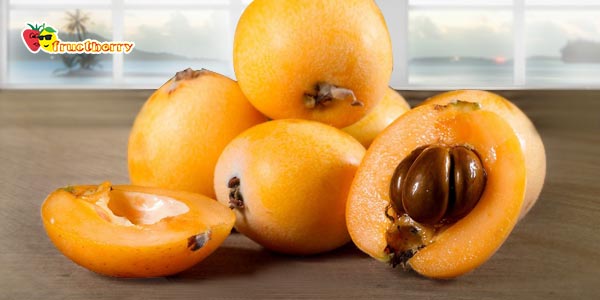

Overall impact
The vitamin and mineral set of the fruit has a beneficial effect on human health:
- Vitamins A and C strengthen the immune system, increasing the body's resistance to harmful microorganisms and infections.
- Fiber normalizes digestion. The astringent properties of tannins (especially in unripe fruits) stop diarrhea. Ripe fruits are good for constipation.
- The abundance of water in fruits cleanses the body of toxins, radionuclides and toxins.
- Almost complete composition of B vitamins normalizes blood pressure, heals the heart and blood vessels.
- Carotene is good for the eyes (its content in medlar is 1500 times the "carrot" indicator).
- Improves the functioning of the liver, pancreas.
- Prevention of the development of oncology.
The fruit is useful as a tool for improving reproductive health, facilitating the female cycle, increasing male potency, and insurance against prostatitis. The fruits of the medlar allow you to stay young longer, prevent skin fading, the appearance of early wrinkles. Ground fruit pits, brewed with boiling water, are useful as a substitute for coffee for those for whom caffeine is contraindicated. The pits of the fruit are toxic, so they are used only when processed. That is, dried or fried.
Blooming room medlar
During flowering, medlar is an excellent honey plant, its aroma is comparable to that of almonds. Fruits contain up to 10% sugars, 1.1% malic acid, 1.6-15.8 mg% vitamin C. Also, fruits contain a lot of vitamin A and potassium. Indoor loquat is eaten raw and salted, marshmallow, wine, compotes, preserves, jams, candied fruits, soft drinks are prepared from it. In the Mediterranean countries, a surrogate coffee is prepared from the seeds.
Medlar fruits have a diuretic effect, so the plant is very popular in folk medicine.
The leaves are used as an expectorant and for coughs, bronchitis, urinary disorders, fever, hemoptysis, nausea, whooping cough, and stomach pains. Local external use - for nosebleeds, with a weathered, inflamed face, pockmarks, ulcers, wounds.Erythrobium flowers are used for acute rhinitis and as an expectorant; fruits - for coughing and nausea.
Contraindications medlar harm
The ripe fruit, especially the Japanese medlar, is safe and healthy for most people.
Individual intolerance to fruits can become an obstacle. In this case, compatibility is checked in a standard way: they eat one or two fruits and if the body has not "rebelled", everything is in order. The same is done when giving fruit to nursing mothers or children.
Children are given medlar no earlier than three years of age and only after consulting a pediatrician. A half or one fruit is enough for a child.
Contraindications apply to the following health problems:
- chronic ulcers, gastritis, pancreatic diseases;
- cholecystitis;
- increased acidity of the stomach - high acidity of the fruit will aggravate the problem.
Ripe fruit is sometimes acceptable, but unripe specimens of medlar, juices or wine are strictly prohibited.
Processed or dried fruits in the form of compote, jam, preserves, dried fruits are safe and healthy in any case.
Even a ripe healthy fruit will harm a healthy person if overeating. An adult needs five to seven fruits a day, a child - one or two. With fanatical eating of medlar, allergies can be provoked.
Growing conditions
In gardens, the tree is grown outdoors. For temperate latitudes, it is recommended to choose cold-resistant varieties:
- Karadag;
- Sochinskaya;
- Sweet Dracheva;
- Goytkhskaya;
- Khvamli.
Conditions most favorable for the cultivation of German medlar:
- Climate. The tree is thermophilic, but frost-resistant. Some species survive even at temperatures as low as –30 ° C.
- The soil. The fertility of the soil is not of great importance, however, excessive moisture and close-lying (less than 1 m) groundwater are contraindicated for the plant. Good drainage is required. The soil is neutral or slightly acidic.
- Illumination. For medlar, you need to select a well-lit area: in partial shade, the yield of the tree is significantly reduced.
When to collect medlar fruits how to store
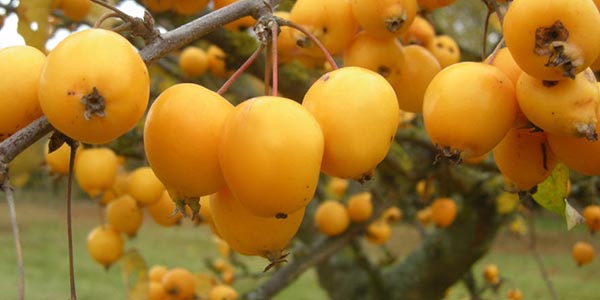

The crop is harvested at different times. This is determined by the type of tree and the growing area:
- Japanese berry. In Turkey and the southern United States, fruits ripen in March-April, on the Black Sea coast a month later. In June-July - on the South Coast.
The fruits of the Japanese medlar reach their condition only on a branch, therefore they are removed ripe.
Fruit is stored for three to four days in a room or refrigerator.
- The fruits of the German variety are usually removed after the first frost: the fruits are softened and suitable for consumption. If frosts are not expected or the fruits are needed for medicinal purposes, the harvest is harvested in November or December, the fruit is poured with saline and left in a cool place. After two to three weeks, the pulp is tender and tasty. However, the fruits wrinkle and become smaller.
Some people prefer to harvest medlar gradually, until early spring. Leaves for medicinal use are harvested in August. It is better to choose fruits of any variety of medium size and hardness, without dark spots.
Outdoor cultivation
For growing in the garden, it is recommended to purchase seedlings in proven nurseries or to transfer a sprouted bush with your own hands.
Seat selection
For medlar it is necessary to choose sunny flat areas with deep groundwater. The central areas of the garden are perfect: the trees will attract attention from afar. For group plantings, the distance between the trunks should be taken into account. It should be at least 2 m. Heavy clay soils are undesirable. The soil should be loose, neutral or slightly acidic. Nutritional value does not matter much.
Planting and transplanting
For planting, pits are prepared with a depth and width of about 70 cm. In this case, the volume of the root system and the drainage layer are taken into account. The holes should freely accommodate the roots, about около of their volume should be left empty.
- Broken brick, gravel or expanded clay 15 cm thick is preliminarily placed on the bottom. This will save the roots from getting wet during heavy rainfall.
- The soil from the holes is mixed with peat, sand and humus. At the bottom, it is advisable to put a complex mineral fertilizer, then pour ¼ of the soil.
- Trees are placed in the center of the holes, the roots are carefully covered with earth. The neck should be flush with the surface.
- It is advisable to strengthen the support stakes next to the plants, and tie them after the first watering.
- The circles around the trunks can be mulched with sawdust or peat in a layer of 5 cm.
The rules for planting medlar are common for all fruit crops. Seedlings from closed ground are carefully transferred along with a lump of soil on the roots. This is done before the start of the active growing season: at the end of April.


Correct pruning
In early spring, before the snow completely melts, they begin sanitary pruning. Frozen, sick, broken by the wind, growing inward branches are cut. They do this from the first years after planting.
They begin to form a crown from the age of 5-6 years.... In the early years, medlar can grow very slowly, adding no more than 10 cm in height per year. Growing up trees beginning to bloom develop faster, become more resistant to cold weather. In the middle of summer, young shoots are shortened by half the length, skeletal ones - at first by ⅓, in the second year - by ¼. Then they just keep in shape.
Watering
It is necessary to moisturize young trees often: once every 5 days, 15 liters of water for each trunk. During the rainy period - after 15 days. An adult crop requires additional watering during dry periods and during flowering.
Waterlogging the soil is unacceptable... It is recommended to water the medlar with scattered jets of water. Sprinkling of crowns can be carried out at the same time. To retain moisture in the soil, it is advisable to loosen it every week and renew the mulch layer.
Top dressing
Trees should be fertilized at least 2 times a season. Young seedlings need feeding more often: every 20 days. It is recommended to apply liquid manure, phosphorus and potassium compounds, wood ash, bone meal. Organics and minerals alternate.
Diseases and parasites
Medlar is resistant to most known garden parasites and infections. Occasionally, the crown can be affected by gray rot or powdery mildew. For prophylaxis in spring, plants must be treated with Bordeaux liquid.
When attacked by leaf-gnawing caterpillars, scale insects or mealybugs, you should pick up the nests of parasites by hand, then wash the crowns with soda or garlic infusion with laundry soap. Chemical insecticides are used with caution, just not during flowering and ripening of fruits.
Medlar
So, in more detail. The beneficial properties of the Germanic medlar were known even in the territories of Mesopotamia and Ancient Babylon. It was freely traded, transported to the west by ships. From here it came to European lands. Today medlar is grown in the north of Iran, in Greece, Azerbaijan, Algeria, Transcaucasia, Asia Minor, the Balkans and the Crimean mountains. This tree grows on slightly acidic soil in sunny, dry places.
The German medlar is distinguished by its round shape, slightly flattened along the axis, and sepals deployed at the end. The fruits are small in size - about two to three centimeters in diameter. They ripen only after the first autumn frosts. Or in the case when they lie indoors for a month.
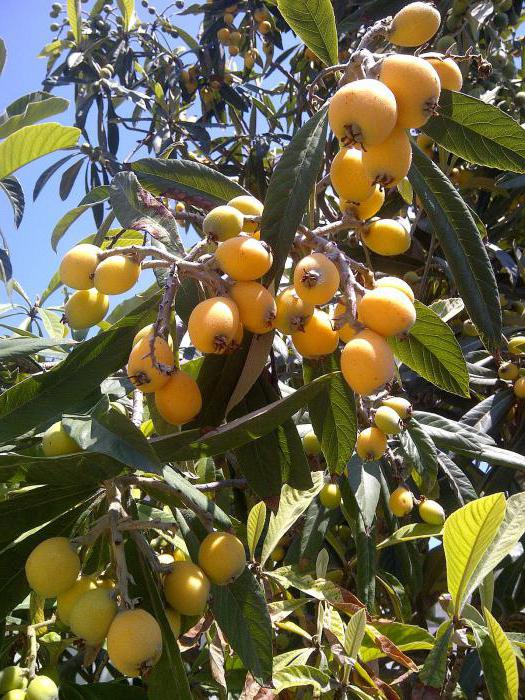

How much does it cost in stores in Russia
Medlar is considered an exotic fruit, so it is quite difficult to find it in supermarkets. Buy a berry is offered by specialized online stores that deliver food to your home.
| Products | price, rub. |
| Medlar (Russia), 1 kg | 308,00 |
| Sapling Medlar Premier | 1500,00 |
| Medlar in syrup (China), 567g | 180,00 |
Medlar is not whimsical to care for, so it will not be difficult to grow it in a summer cottage.It will become a good garden decoration with moderate watering and regular mineral feeding.
In cooking
Of course, the easiest way to peel the fruit is to enjoy its sweet, spicy flavor raw. However, gourmets prefer various interesting recipes. Among them: medlar jam, custard, fruit salad, etc. The leaves are also used in cooking.
Medlar compote is incredibly popular in Japanese cuisine. The same as the tea brewed with it. Filled with water, boiled, with the addition of basil, ginger, turmeric - an excellent and healthy drink with an incredibly mild and pleasant taste.
You can also make jam from medlar. To do this, you need to take a couple of cups of fruit without seeds. You need to make fruit puree out of them. Heat two cups of water. Once it boils, add a glass of sugar and fruit pulp. Stir the mixture until smooth, leave to boil. As soon as the jam is gelatinized, it is ready. You can add a little cardamom or cinnamon there. Ready jam is rolled into sterilized jars, and stored throughout the winter.
You can also make a sauce from medlar. To do this, cut the medlar and apricot into small slices, add garlic, ginger and caraway seeds to the mixture. Season with salt and pepper to taste. You can add a little lemon juice and sugar for piquancy.
Popular varieties
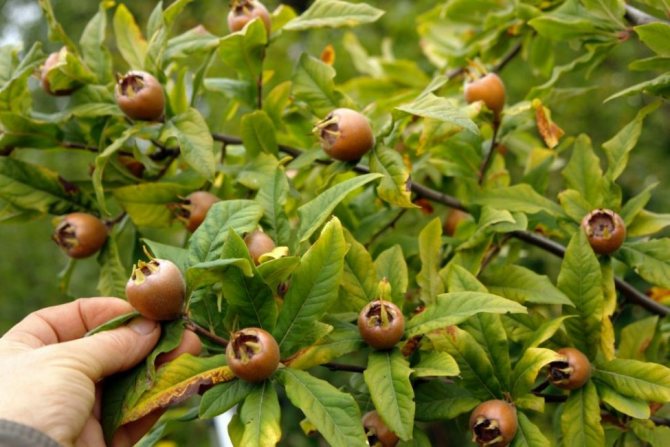

Different types of pine cones have different organoleptic properties.
The varietal variety of medlar is very rich. Depending on the variety, Japanese or German, the fruits can be roughly divided into two types: large pear-shaped with soft juicy pulp and small firm, apple-like fruits with noticeable acidity.
The most popular varieties of the cup tree are presented in the table.
| Variety name | Properties |
| Champagne | Fruits are fluffy, yellow with a creamy pulp with a slightly sour taste |
| Tanaka | Fruits are orange, pear-shaped, weighing up to 70 g, with a delicate taste and fragrant pulp |
| Premier | Creamy yellowish orange fruits with slightly sour flesh |
| Komun | Small rounded fruits weighing up to 30 g, slightly flattened, bright yellow |
| Sayles | Deep orange fruits, large, similar to apricot both in appearance and in taste |
| Morozko | A frost-resistant plant with a low level of fragility of the trunk, fruits are large, fragrant, bright brown with a high content of nutrients |
Among the varieties loved by gardeners are also distinguished: Monreale (Italy), Thales, Tams Pride (Australia), Advance, Uze-fangzhun (China), Early red (USA).
On the territory of Russia, the following varieties are recommended for cultivation: Sochinskaya, Khvamli, Karadagskaya, Goytkhskaya.
Fruits of any variety tolerate transportation well and are stored for a long time, and the fruits of Germanic Eriobotria even need to be frozen to improve their taste.
back to menu ↑
See also: Gooseberry is a northern grape. Description, varieties, planting in the open field and care in spring, summer and autumn (20 Photos & Videos) + Reviews
Medicinal medlar tea
Tea made from medlar is used as an alternative remedy for dizziness, infections of the mouth and throat, and also as a drug that enhances potency in men. This remedy will also help with bleeding gums, relieve bad breath. And since medlar does not contain many calories, it is safe for people on a diet or diabetes.
How to cook
To prepare this drink, you will need 2 medlar. Finely chop the berries and pour 200 ml of boiling water. Cover and leave for an hour. Strain and take three times a day.
Medlar for maintaining a slim figure
All recipes for weight loss, as a rule, are aimed at stabilizing the work of the gastrointestinal tract and removing water. Medlar is fully consistent with these goals. Eating fruits from this tree strengthens the intestines, cleanses the body well and saturates it with useful substances.The biochemical composition of the fruit will help you not feel hungry. It is useful to use the fruits on fasting days, because the fruit is low in calories and rich in fiber. The medlar diet should be only one day a week. However, it is not recommended to consume more than one kilogram of fruit.
- Modelform 18 plus, reviews of losing weight and instructions
- Photo and description of the breadfruit - where it grows, useful properties of fruits and growing at home
- Useful properties of quince - cooking recipes. Quince - benefits and contraindications
The benefits of medlar leaves
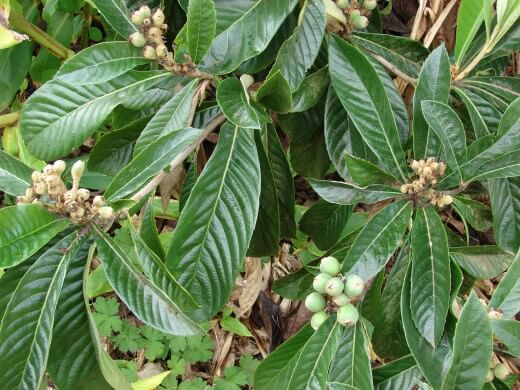

The leaves of this tree have many medicinal properties. An extract from them or a decoction is used for:
- strengthening immunity;
- treating diabetes (increases the production of insulin);
- promoting the health of the pancreas;
- cleansing the liver;
- treatment of skin inflammation (added to creams);
- fight against viral diseases;
- getting rid of depression;
- improving the condition of people with HIV.
Medlar fruit in medicine
The fruits of an evergreen plant have a number of beneficial properties that have been known since ancient times. In the field of traditional medicine, there are many recipes based on medlar. For example, decoctions can be made from unripe fruits to treat diseases of the genitourinary system. Fruit-based decoctions are used in cases of gastrointestinal inflammation and bloody diarrhea. Alcohol tinctures are made from the pulp, which help with bronchial asthma. Fruit is also useful for vascular and heart diseases. They can also help clear kidney stones and improve colic conditions.
We advise you to read:
mango in medicine
To read
Origin story
It is China that is considered to be the homeland of this exotic plant, whose fruits taste like strawberries, quince and ripe pears at the same time. The warm subtropical climate of China and similar countries contributed to the successful growth and fruiting of this tree.
It is worth noting that under favorable conditions the tree can grow up to ten meters! However, most often there are more modest specimens up to five to six meters high, with a spreading crown and lush foliage.
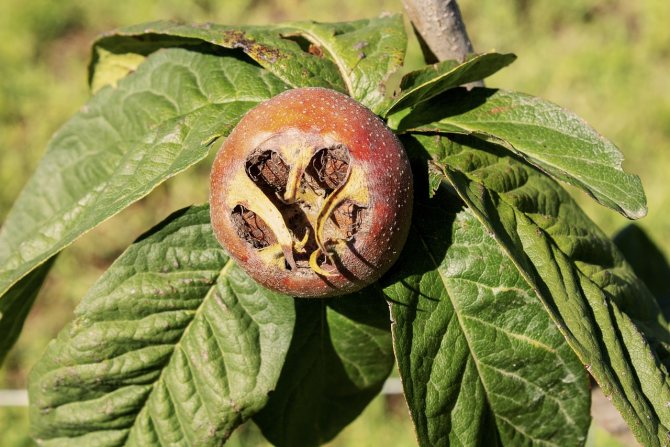

Where does this tree grow? Medlar prefers slightly acidic, well-drained mails. In addition, the tree loves well-lit glades, with bright diffused light. Under no circumstances should it be allowed to flood with groundwater!
A constant flow and circulation of air is also necessary for successful growth. If the plant is planted in a lowland, in a dimly lit place, do not expect any sense from such cultivation.
Grown in good and comfortable conditions, the fruits are distinguished by a delicate and sweet taste. And, conversely, if the medlar lacks nutrients, the fruit will sour, differ in small size and small amount during the period of ripening and fruit ovary.
The Caucasian medlar differs from other species mainly in that it can grow in cooler climatic conditions. During the season, it is possible to collect about ten to fifteen small round-shaped fruits from the tree. Below will be given an external description of the Caucasian variety of medlar.
About
How to choose the right one
The fruit should not be eaten immediately after harvest. They should lie for a while in a dark and cool place until they acquire a soft texture and brown color. Ideal berries have a slightly rotten look, which is why many consider the medlar unattractive.
When buying, you should choose a lock:
- large in size, since small berries are very sour and less juicy;
- uniform color without black spots and damage;
- wrinkled but juicy structure.
Before eating the medlar, you need to peel and remove the seeds.
Briefly about the main
Medlar, lokva or Chinese plum is an evergreen plant of the Rosehip family, which has large racemose berries.The tree belongs to the related branches of pear, hawthorn and quince. His homeland is China, in particular regions where the subtropical climate prevails. From the territory of the Celestial Empire, the medlar began to wander, first to Japan, and then to Europe. Today fruit crops are grown in many countries of the world:
- India;
- Russia (in Crimea);
- USA;
- Georgia;
- Ukraine;
- Turkey;
- Moldova;
- in the countries of Southeast Asia.
Medlar bloom begins in autumn, and berries ripen in mid-late May.
Fruits up to 8-10 cm in diameter are similar to apricot or cherry plum, since they are pear-shaped. The pulp, which is sweet and sour in taste, resembles a cocktail of apples, strawberries and apricots, has a juicy structure. It is covered with a dense skin, the color of which can vary from light yellow to brown. Inside the berry, oblong seeds are dark brown in color.
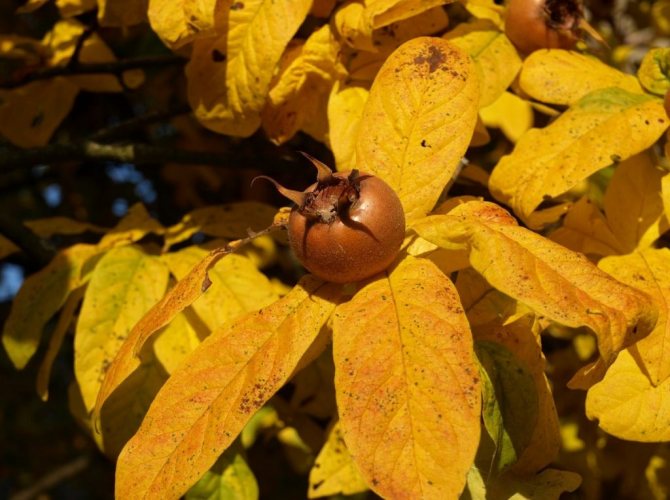

Sochi variety
What to cook from medlar
This fruit is used for making juices, tea, jams, liqueurs. It can be consumed in any form, while being sure that the body will still feel the benefits from it. Here are some ideas for what you can cook them medlar.
Jam
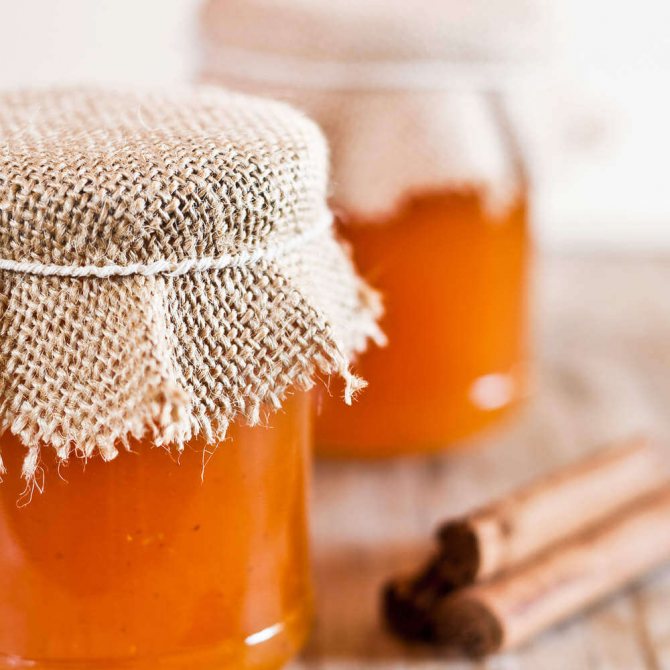

Once upon a time, medlar jam was not an exotic dessert, but a traditional preparation for the winter. To make this delicious jam according to an old recipe, you will need:
- medlar (1 kg);
- honey (1 kg);
- water (0.7 l).
Mix water with honey and boil. Add well washed berries to the boiling mixture. Cook for 50 minutes, stirring constantly. Pour jam (still hot) into sterilized jars, roll up and store in a cool place.
Liquor
To prepare this drink you will have to prepare:
- medlar (250 g);
- water (2 l);
- brown sugar (130 g);
- brandy or cognac (500 ml).
Rinse the fruits thoroughly, peel off the stems and pour into a glass container with a wide neck. Boil water with sugar and cool a little, then pour into a bottle, and then add cognac. Close the vessel tightly and shake to mix the ingredients. Insist for about 14 days at room temperature. It is important to shake the vessel daily. After 14 days of fermentation, strain through cheesecloth and can be consumed.
Medlar is known for many beneficial properties that are striking in their healing power. But this is easily explained by the rich mineral and vitamin composition. However, in some cases, this wonderful fruit can be dangerous.
More fresh and relevant health information on our Telegram channel. Subscribe: https://t.me/

